

|
| 3.2.4 |
The Mid Tide Zone(sometimes called Zone 3)
| Aggregating Anemones The aggregating anemone, Anthopleura elegantissima, dominates Santa Barbara's rocky shoreline from sea level to 2.5 feet above sea level, not because it is a good competitor for space, but because the sea star has removed all mussels and most everything else with a shell (barnacles, snails, limpets). The sea star does not prefer to eat (or even touch) the anemones, so the anemones exist here without a predator and without any space competition with the shelled species. 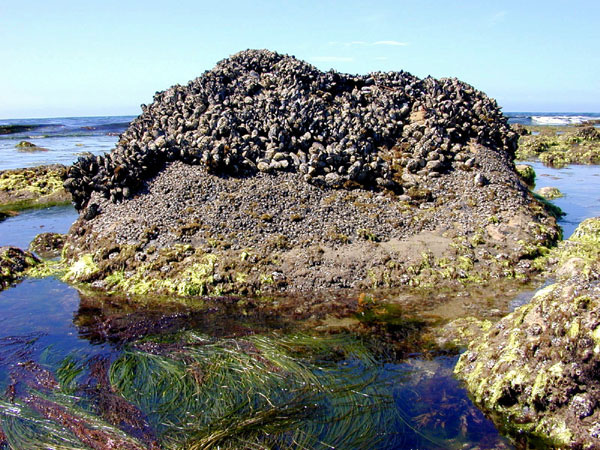
Each anemone is round, with a mouth in the middle. The mouth is surrounded by feeding tentacles that have stinging cells capable of capturing small crustaceans, fish and anything that happens to touch them that cannot get away. The tentacles feel sticky to humans, but we are only feeling their 'sticky' cells. The real stinging cells of the aggregating anemone cannot penetrate our hands so it is safe to touch them. But there are stinging cells that might irritate sensitive flesh so I always warn my students that 'kissing' anemones is not allowed. 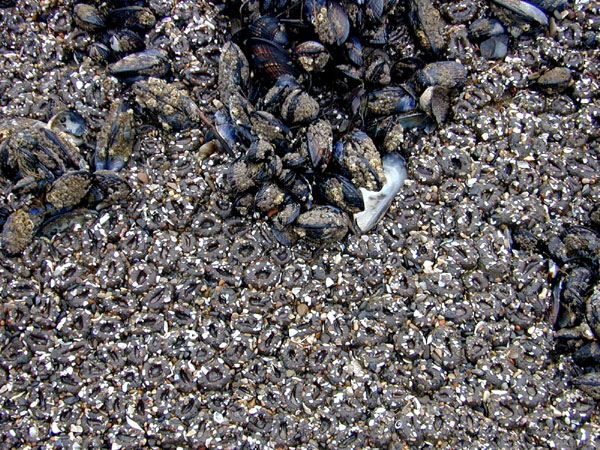
Food that is gathered by the tentacles is pulled to the mouth where it is ingested and digested. They are very simple animals, without a complete digestive tract, and thus there is no anus. So, ingested material that is not digested (like shells and bones) must be regurgitated back out the mouth. Sounds rather unpleasant, but this explains why sometimes the tidepool anemones look like they are turning inside out. Wayward periwinkle snails, if they have toppled from their high perch, may be swallowed by these anemones, but the snail will usually keep its trap door operculum closed until the anemone tires of its presence. Then, when the anemone spits it out, the periwinkle snail starts its long trip back up the rock to its preferred (and safe) Splash Zone. 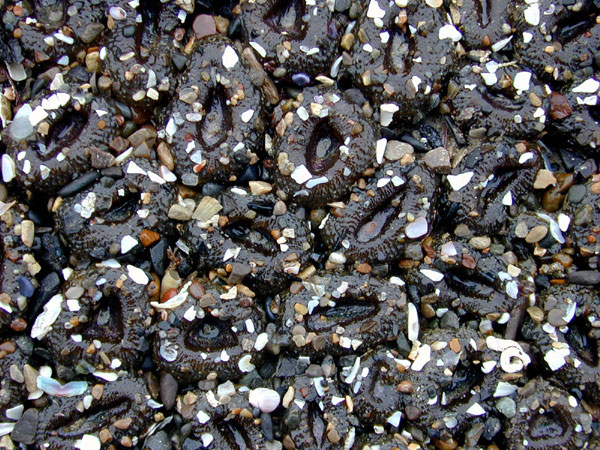
At low tide these anemones pull in their tentacles and become a lump on the rock. The sides of their bodies are covered with adhesive structures that attach bits of shell, rock and seaweed. When closed up at low tide the attached material causes the anemone to look like a bed of crushed shell, but when you touch it, the anemone (whose body can be up to 80 percent water) releases water and feels gushy. The bits of debris probably reflect light to keep the anemone cooler and reduce water loss at low tide since these critters do not have a protective shell. The debris could also be dispersing wave action as the tide ebbs and flows each day. 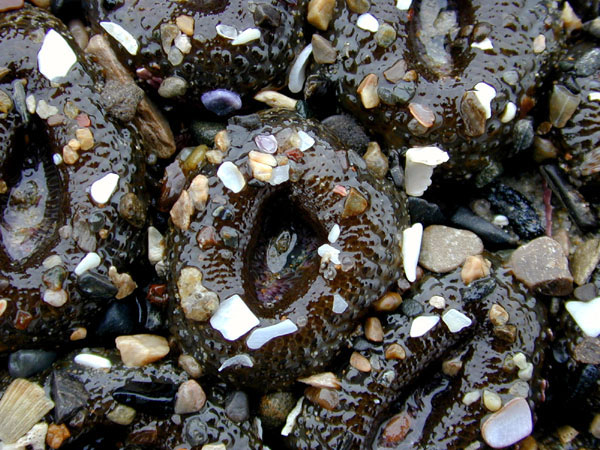
This species is one of the most exciting (to me) in the tidepools, not because of what it does while we are watching at low tide, but because of what it does at high tide. At high tide, this species can split down the middle, pull apart and reform, resulting in two identical (but smaller) individuals. Each of these divides repeatedly until there are hundreds of aggregating anemones, all crowded together (thus the name aggregating). Each animal in the group is genetically identical, a clone. 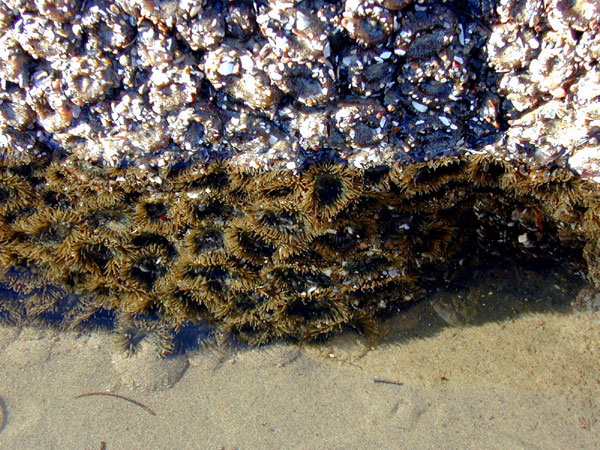
The most exciting thing happens when two clones meet. Members of the same clone extend their tentacles at high tide and do not mind touching members of their own clone but, should a member of another clone be touched, they fight until one moves or dies. There are special fighting tentacles (that are deflated and not visible until a clone war starts) tucked just under the regular tentacles and the outside of the body. These special fighting tentacles are called acrorhagi and during a clone war they are inflated. They look different than the regular tentacles, being shorter, rounder, and very white. These acrorhagi are fully illustrated later in this lesson when discussing the starburst anemone. The clone war is a slow motion confrontation with the clonal adversaries stretching toward their enemy to touch the acrorhagi. The acrorhagi have nasty stinging cells that damage the tissue of whatever they touch. Back and forth for hours these anemone enemies fight until one moves or dies. This behavior leaves wonderfully obvious anemone-free areas in the Mid Tide Zone wherever two clones meet. We don't have to do DNA analysis to know there are two (or more) clones present on the intertidal rocks. Other critters may use these anemone-free areas to travel through the Mid Tide Zone.
The aggregating anemone not only asexually reproduces to form clones, but once a year it releases eggs or sperm into the water as a broadcast spawner. Its planktonic larva is the source of the original anemone on the rocky shore that forms each clone. These anemones are separate-sexed so each clone is either all male or all female. As you view the Mid Tide Zone and get close to sea level, you are likely to encounter the 'star' of the tidepool tales - literally. That would be the sea star, roaming the rocks in search of anything with a shell to eat. 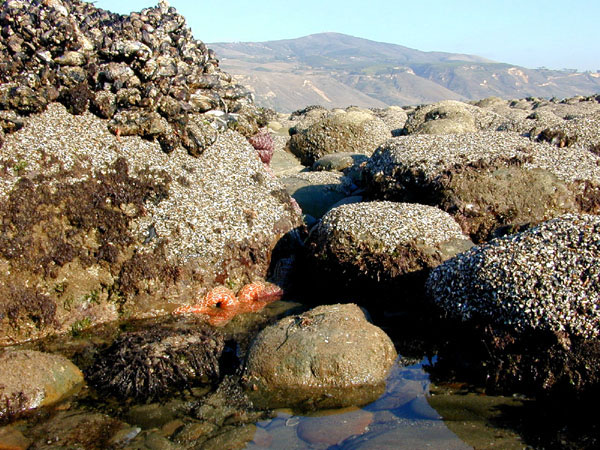
Sea Stars Not an indicator of the Mid Tide Zone, nor even commonly found there (at low tide), the sea star has a profound effect on the Mid Tide Zone due to its presence there at high tide. The most common sea star species in the Santa Barbara tidepools is one of the knobby sea stars, Pisaster ochraceus, also called the ochre sea star. 
Each ochre sea star can eat up to 80 adult mussels each year and thousands of barnacles. This is the 'keystone species' in our rocky intertidal. Without its presence the mussels would dominate and species, like the aggregating anemone, would be crowded out. Furthermore, there would not be the great diversity of species encountered in the Low Tide Zone (below sea level) that I like to refer to as 'treasures.' Everything would be overgrown by mussels. 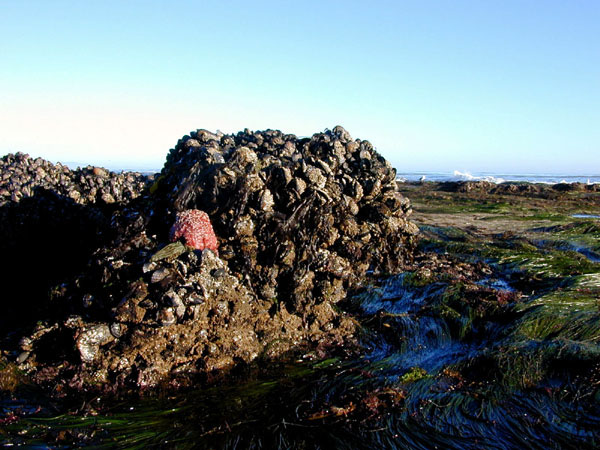

The sea star's preference for shellfish is because they are uniquely adapted to hold onto solid shell with hundreds of sucker-tipped tube feet that are found under each leg. 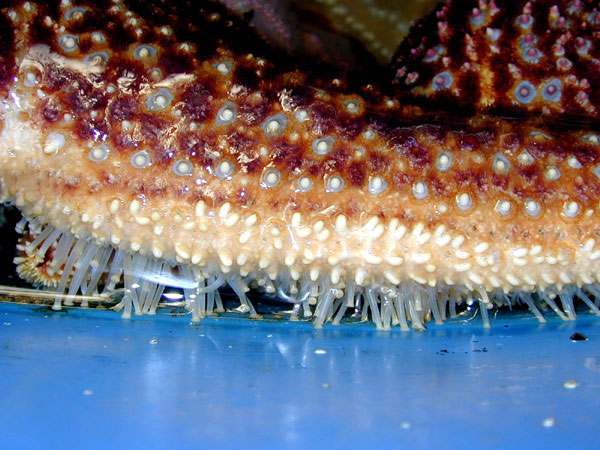
These are run by water pressure that enters the sea star through a special sieve plate on the upper surface of its body. 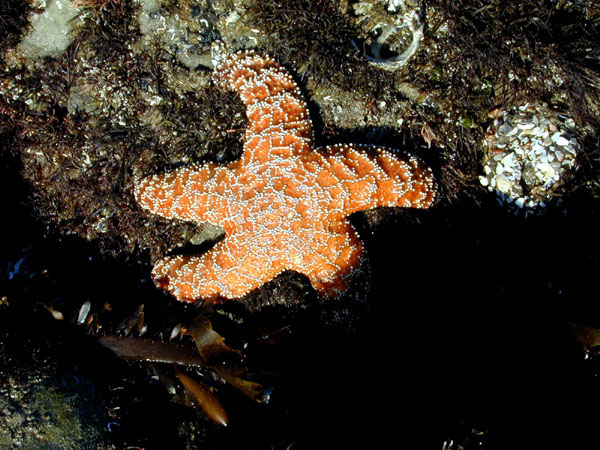
This sieve plate (also called a madrepore) can usually be seen if you look closely at the back of a sea star just off-center.
The tube feet can pull two pieces of shell apart for hours (or days, if needed) until their prey tires. Sea stars never tire of pulling open a shellfish because they have hundreds of tube feet - always resting a few. Once there is the tiniest crack (a tenth of a millimeter is all that is needed) the stomach of the sea star can emerge, ooze into the crack and digest the prey. In general, it takes more than six hours to consume a mussel. The upper limit of where sea stars prey on their favorite food, the mussel, is 2.5 feet above sea level because the rocky shore dries out every six hours when you get higher than this (the High Tide Zone) and sea stars do not tolerate that much dryness. The sea star is one of the top predators in the ocean - few things prey on sea stars. It is the desperate shark and a few sea otters that are the main sea star predators. Even then, if the predator just bites off an arm or two, the sea star has amazing regenerative abilities, and can often regrow missing arms. They can sometimes even regrow an entirely new animal from just one leg. They have sexual reproduction mostly during spring and summer. This occurs when the separate-sexed adults release their eggs and sperm from five openings on their top surface. Often when one sea star spawns this causes those nearby to also spawn, creating a concentrated mass of eggs and sperm in nearby waters - increasing the chance for fertilization. This broadcast spawning is well known by aquariums that quickly remove any spawning sea stars so as not to cloud the water for their visitors. Sea star wasting syndrome hit the West Coast of North America in the Fall of 2013. It started in Alaska and reached northern Baja California, Mexico by March 2014. The sea stars, including at least 20 species, decay and die. There have been other events on the West Coast associated with El Ninos in the early 1980s and late 1990s but none as widespread or long lasting as the current one. During this event there are numerous scientists from Alaska, Canada, three states in the USA (Washington, Oregon, California) and Mexico collaborating as well as citizen scientists being trained to send in data. The winter of 2014 an uncommonly large recruitment of juvenile sea stars was commonly seen along the California coast. Some marine biologists theorize that this could have resulted from a mass spawning event from dying sea stars. The almost complete lack of living sea stars may give scientists a unique opportunity to test the "Keystone Species" theory that the sea stars are the primary reason zones 3 and 4 have the indicator species and diversity commonly. It will be interesting to follow this event and photograph the zones shown in this lesson. If the "Keystone Species" theory is correct the mussel colonies should begin expanding. A group of scientists, including several at Cornell discovered the source of the sea star wasting syndrome to be a densovirus (named SSaDV for Sea Star associated DensoVirus). Research has showed that this virus has been present since the 1940s at low levels but no one is sure of what trigers the disease or widespread outbreaks. |
(Revised 21 November 2015) |